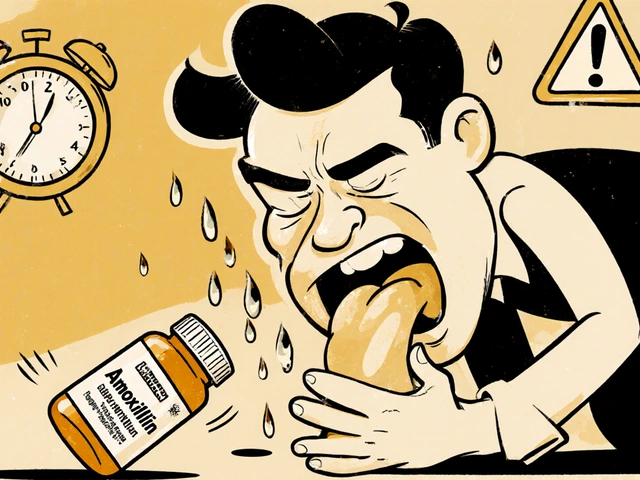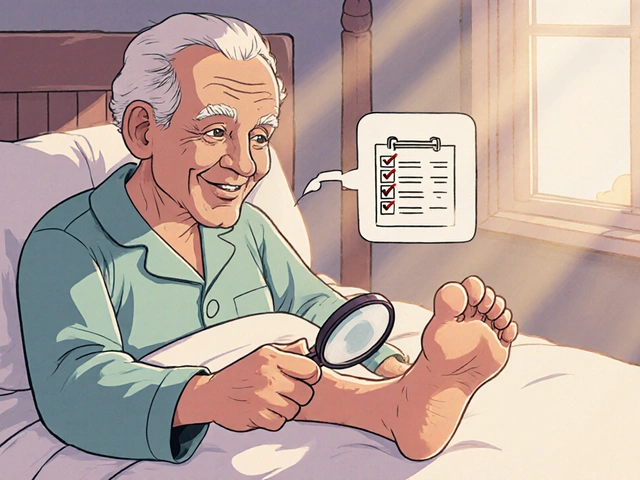Walk into any Aussie pharmacy and mention you’re struggling with depression or overwhelming anxiety, and you'll likely hear the name Paxil tossed around. Millions have tried it, and it’s sparked plenty of chatter—some swear by it, others have stories that are a bit shakier. Now that mental health is finally stepping out of the shadows, it's wild how a single small tablet can be both a game-changer and a challenge for so many. What’s the real scoop with Paxil? Glad you asked, because this isn’t just another clinical info-dump. Let’s get into what you actually want to know.
What is Paxil and How Does It Work?
Paxil is the brand name for paroxetine, which sits in the selective serotonin reuptake inhibitor (SSRI) family. If that label sounds like a mouthful, think about it this way: your brain relies on a bunch of chemicals swirling around, and serotonin is one of the headliners when it comes to balancing mood, sleep, and even your appetite. Paxil’s job is pretty simple at its core—it helps keep more serotonin floating in your brain’s synapses, so you get a smoother, less bumpy mental ride.
This medication isn’t fresh out of the lab. Paxil hit the scene back in 1992, quickly winning the green light for depression, and then gaining more approvals for generalised anxiety, panic disorder, obsessive compulsive disorder (OCD), social phobia, and posttraumatic stress disorder (PTSD). Off-label, some doctors have even scribbled out scripts for things like premature ejaculation and severe premenstrual symptoms. And while its popularity has jostled a bit with newcomers like escitalopram or sertraline, there’s a good reason pharmacies in Perth and around the globe still stock stacks of Paxil.
What’s especially important is how precise doctors try to be with the dose. Starting low—sometimes as tiny as 10mg a day—and then creeping up to as much as 60mg, folks usually notice the first changes after a couple of weeks. If you’re used to the idea of a tablet kicking in overnight, Paxil will test your patience a bit; it’s building up in your system, plugging away slowly on those serotonin highways.
Here’s a quick look at how Paxil fits into the world of antidepressants:
| Brand Name | Generic Name | Type | Common Starting Dose | Years Approved |
|---|---|---|---|---|
| Paxil | Paroxetine | SSRI | 10-20mg | 1992 |
| Prozac | Fluoxetine | SSRI | 10-20mg | 1988 |
| Zoloft | Sertraline | SSRI | 25-50mg | 1991 |
| Cymbalta | Duloxetine | SNRI | 30-60mg | 2004 |
SSRIs like Paxil have a decent safety record, especially compared to the really old-school antidepressants (tricyclics or MAOIs), which made you feel like you couldn’t eat cheese or drink wine or basically have fun at all. But Paxil isn’t perfect. Some people feel a lot better, while others, well, they run into rough patches. The key is knowing the facts and figuring out if Paxil’s particular style matches your own brain chemistry.

The Most Common Effects: What Real People Say About Paxil
No two brains fire quite the same, so ask ten people about their ride with Paxil and you’ll hear some seriously different tales. There’s a reason forums are packed with everything from glowing reviews about finally getting out of bed, to brutally honest stories about emotional numbness. So how do you separate the signal from the noise?
First off, the majority of people who stick with Paxil do say it takes the sharpest edge off their anxiety or depression. Lots of anxious folks talk about finally leaving the house or not sweating through shirts at work meetings. In one 2023 clinical survey out of Melbourne, about 68% of users reported feeling a "moderate" or "significant" improvement within two months. That doesn’t mean life becomes perfect, but for someone whose low moods or panic have made life tiny and gray, it’s a welcome shift.
But there’s a flip side. Some report initial side effects that can make you want to chuck the blister pack straight into Perth’s Swan River. At the start, it’s not unusual to get hit with nausea, headaches, dry mouth, or an odd sense of jitteriness—think a mild hangover mixed with a restless stomach. Many doctors suggest taking it in the evening if the daytime drowsiness is a killer, or with food to sidestep the gut twists. Sexual side effects also pop up (no pun intended) for a significant number—reduced libido, difficulty reaching orgasm, or delayed ejaculation. This is awkward to talk about, but it’s real: nobody wants better mental health if their love life crashes and burns. If things stay rough, it’s worth bringing it up with your GP, because switching meds or tweaking the dose can fix a lot.
Then there’s emotional blunting—a weird numbness where you don’t feel the highs or the lows quite as sharply. Some folks find it a relief, while others say it dulls their personality. The phrase “I feel less like myself” pops up often. This isn’t universal, but something to watch for, especially if your old passions seem to vanish.
Weight gain? That’s a sore spot for some. While not as notorious as mirtazapine or some mood stabilizers, Paxil users do report more creeping pounds than those on, say, Prozac. There’s been research showing around 8-12% of users see a visible boost on the scales after six months. Keeping active, eating more greens than chips, and helping your body process the med can make a real difference.
The withdrawal stories are real, too. Paxil can be tough to come off, probably the SSRIs' biggest Achilles’ heel. Unlike fluoxetine, which can linger for weeks, Paxil leaves your body quicker. Stop it cold turkey and you might get "brain zaps" (weird electrical shock feelings in your head), mood swings, dizziness, and flu-like aches. Tapering down slow, guided by your doctor, spares you most of this chaos.
To keep it all tidy, here’s some real-world tips from patients, counsellors, and GPs in Australia:
- Track side effects in a journal for the first month—patterns help doctors fine-tune your dose.
- Stay hydrated—dry mouth and headaches are common when starting.
- If sexual side effects crop up, don’t be embarrassed. Raising it with your doctor gets you way closer to a solution.
- If you miss a dose, don’t double up next time. Just move forward as normal.
- Coming off? Never quit cold turkey. Work out a solid taper plan with your prescriber.
- Combine medication with regular therapy for better results—meds are rarely the whole answer alone.
Living with Paxil isn’t a one-size-fits-all story. Some see their world brighten, others run into speedbumps. If you’re starting out, expect patience: things settle after a few weeks. Walking in with realistic expectations goes further than any miracle-cure hype.

Making Paxil Work for You: Practical Advice and What to Know Before You Start
Choosing to start antidepressant treatment can feel like a leap into the unknown. There’s a weird mix of hope and anxiety—will this tablet smooth things out, or just swap sadness for something else? Here’s where some straight-talk and preparation help set you up for a smoother ride with paxil.
For starters, open communication with your doctor is a lifesaver. Don’t hold back about previous meds, allergies, or any “I heard this horror story” stuff rattling around your head. Many folks are surprised how much their sleep, diet, or other conditions (like migraines or epilepsy) might influence the safest choice and starting dose. If you’re pregnant or breastfeeding, it gets even more complex—recent guidance in Australia suggests avoiding Paxil during the first trimester due to potential risks to the baby. So those first chats with your GP matter more than you think.
Once you’re actually holding that script, timing and consistency are two pillars worth nailing down. Try to take Paxil at the same time each day—your body likes routine, especially when it comes to brain chemistry. Morning or evening? Up to you and your side effects. If you’re sleepy, go for dinner or bedtime. Jittery or wired? Maybe after brekkie works better.
Some people are stunned to hear you shouldn’t mix SSRIs with certain things. Most doctors tell you to steer clear of alcohol, at least at first, because it can mess with both the side effects and your overall mood. And if you’re fond of herbal teas, be careful with St. John’s Wort. Mixing this herbal remedy with Paxil doubles your risk for serotonin syndrome—a rare but dangerous overload of serotonin levels, which can cause confusion, fever, shaking, or even hospitalisation.
If you’ve ever felt “different” on any medication, you get why mental health meds are especially personal. Don’t expect friends or family to instantly get it—sometimes the change is subtle or invisible. Keeping track of how you actually feel (maybe with phone notes or mood trackers) can help you spot changes that aren’t obvious day-to-day. These notes are gold at your next GP visit, making it easier to catch side effects before they snowball or to see which symptoms are actually shifting.
Got kids or teenagers at home? Be aware that Paxil—like most antidepressants—comes with an extra warning for the under-25 crowd. There’s a slightly increased risk of suicidal thinking at the start of treatment in young people, so regular check-ins matter. School counsellors, parents, or mates should keep an eye out for odd behaviour changes in that first month especially.
Insurance and cost don’t get much attention in medical leaflets, but here in Australia, paroxetine is listed on the Pharmaceutical Benefits Scheme (PBS), making it way cheaper than in the States or some other countries. Kids, teens, and folks on pensions often get it for just a few bucks.
If you want to boost the way Paxil works, habits matter. Getting some sunlight every day, even ten minutes on the porch, actually boosts your natural serotonin. Combine the med with a walk along the beach at Cottesloe or a jog around Kings Park, and you’re stacking the odds in your favour. Treatment gets a real kick when healthy habits back up what the medicine’s trying to do.
Here’s a checklist if you’re just starting out on Paxil:
- Decide with your doctor when and how to take it every day, and stick with it.
- Set a phone reminder, especially for the first few months, so you don't miss doses.
- Write down all medications and herbal supplements you take—bring the list to your appointment.
- Start a mood, sleep, and side-effect tracker before you pop the first pill.
- Let your closest mate or family member know you’re starting and what to look for (especially if you’re under 25).
- Check if you’re eligible for a PBS script to save some cash.
- Don’t just rely on medication. Pair it up with therapy, good food, regular sleep, and exercise.
In the world of prescriptions, Paxil has stuck around because it gets people out of bed, out the door, and out of their own heads. It isn’t a “happiness pill”—no such thing exists—but when matched with the right person, it shrinks problems down to size. The biggest wins come to folks who keep their expectations grounded, track their progress, and speak up quickly if things go sideways. At the same time, never blame yourself if Paxil isn’t the golden ticket. Everyone’s brain is a bit of a puzzle; sometimes, it takes a bit of trial and error before the picture looks clear. Make sure to keep those doors open with your doctor—what works for others may not work for you, and there’s always a plan B, C, or even D. Real improvement doesn’t always show up as a Hollywood glow-up. Sometimes it’s just waking up without dread, making it to work with a steady heart, or having a proper laugh at dinner. And on a Friday night in Perth, that feels pretty priceless.






Comments
okay so i tried paxil for 3 months and honestly the brain zaps were like someone was microwaving my frontal lobe lmao 🤯 but the anxiety? gone. like poof. no more panic attacks before meetings. also the weight gain? real. i gained 18lbs and started calling myself "paxil belly". still worth it though. also dont mix with st. john’s wort. i did. i regret nothing. except maybe the zaps.
you’re not alone girl 💪 i was in the same boat. started at 10mg, felt like a zombie for 2 weeks then boom - i actually smiled at my cat. it was a milestone. side effects suck at first but your brain recalibrates. hydration helps with the dry mouth and the sexual stuff? talk to your doc. there’s a med called bupropion that can help counter it. you got this. keep going. it gets better than okay. it gets peaceful.
listen i come from nigeria where mental health is still whispered about and i just want to say thank you for this post because it’s one of the first times i’ve seen someone talk about paxil like it’s real life and not some textbook. my cousin took it for pms and panic attacks and she said the emotional blunting was weird at first like she felt like a robot watching her own life but after 6 weeks she started laughing again at stupid youtube videos and that was the moment we knew it was working. the key is patience and not giving up after two weeks. your brain needs time to learn how to be happy again without screaming. also yes the withdrawal is no joke - we tapered over 10 weeks and it saved her life. don’t quit cold. ever.
just want to say i started paxil last year and the journaling tip? life changing 📓 i wrote down my mood every morning and night. noticed the nausea dropped after week 2, the sleep got better at week 4, and the crying fits stopped at week 6. also the weight gain? real but manageable. i started walking 30 mins a day and it helped so much. therapy + med = 💯. also don’t be ashamed to say "this isn’t working" to your dr. you’re not failing. you’re fine-tuning.
the real magic of paxil isn’t that it makes you happy - it makes you able to tolerate being alive. that’s it. no fireworks no euphoria just… less screaming inside your head. i used to think depression was sadness but it’s actually exhaustion. paxil didn’t fix my life but it gave me the energy to fix it. also the sexual side effects? yeah they’re brutal. but so is being too anxious to kiss someone. sometimes you trade one pain for another. and honestly? i’d take the numbness over the panic any day. still took me 8 months to feel like me again but i’m here. you will be too.
they’re all lying. paxil is a big pharma trap. they made it to keep you dependent. look at the withdrawal - designed to be brutal so you never quit. why? because they make billions off your suffering. and the "68% improvement"? that’s from pharma-funded studies. real people? they’re numb. they’re zombified. they’re not living - they’re surviving on pills. and don’t even get me started on the pbs. it’s a drug pipeline. wake up. therapy doesn’t cost a cent. sunshine doesn’t need a script. you don’t need paxil. you need freedom.
look i’m not saying paxil is evil but come on. america’s mental health crisis is basically a big corporate cash grab. we’re medicating normal sadness now. you ever heard of a walk in the woods? or talking to a friend? or just… crying? paxil’s just a fancy bandaid on a bullet wound. and yeah the side effects? they’re the real product. because if you feel weird you’ll keep taking it. genius. and the withdrawal? that’s not a side effect. that’s a business model. they want you hooked. and the pbs? it’s just the government helping big pharma sell more. you think they care if you’re happy? they care if you keep buying.
I’m sorry, but I have to say this: if you’re relying on a pharmaceutical to feel human, you’re avoiding the real work. Therapy, lifestyle changes, mindfulness - these are the real solutions. Paxil doesn’t heal. It masks. And the emotional blunting? That’s not a side effect - that’s a personality erasure. And the weight gain? That’s your body screaming. And the withdrawal? That’s your brain begging you to stop. You’re not brave for taking it. You’re just… compliant. And for those saying "it worked for me" - maybe you were just lucky. Or maybe you were never truly depressed in the first place. Just… sad. And sadness isn’t a disease. It’s a signal.
One must approach the pharmacological management of affective disorders with the utmost scientific rigor and epistemological humility. Paroxetine, as a selective serotonin reuptake inhibitor, exhibits a pharmacokinetic profile characterized by a relatively short half-life and significant first-pass metabolism, which may contribute to the pronounced discontinuation syndrome observed in a non-trivial subset of the population. Moreover, the clinical efficacy demonstrated in randomized controlled trials is often confounded by publication bias and industry sponsorship. One must therefore exercise caution, and consider the ethical implications of prescribing a drug whose long-term neuroadaptive effects remain incompletely understood. One does not simply "pop a pill" and expect ontological equilibrium.
STOP. JUST. STOP. You people are glorifying a drug that turns people into zombies. Emotional blunting? That’s not "better than panic" - that’s soul death. And you’re all acting like it’s a badge of honor. You’re not "surviving" - you’re numbing. And the journaling? That’s not a fix - that’s a distraction. You think writing down your mood fixes your trauma? No. Therapy does. Movement does. Connection does. Not a pill. Not a pill. NOT A PILLLLLL.
lol paxil? i took it for 2 weeks. got dizzy, nauseous, and felt like my soul was being sucked out through my ears. stopped. still depressed. but at least i’m not a robot. 🤖💀
I’m from India, and here, antidepressants are still seen as "weakness". But I started Paxil last year after my dad passed. It didn’t fix my grief - but it gave me space to feel it without drowning. The first month was hell. But after that? I started writing again. I started walking to the park. I cried - but I also laughed. It didn’t make me happy. But it made me able to be with my pain. And that’s enough. Don’t compare your journey to others. Your brain is yours. Your healing is yours. And if Paxil helped you breathe? That’s not failure. That’s courage.